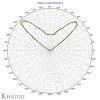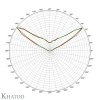I agree the 2x2 may not be enough to show differences. Looking at the plot you get get an idea of light outside the 2x2.
There are 4 PPF data points from the center. 6, 8.49, 12, 16.97 inches.It is possible to estimate the light for 3x3
If cobs are close together in a 3x3 or bigger then best to not use any lens or reflector to ensure max spread. I agree if blending different spectrum best to not use any lens or reflector
These plots do not tell the whole story specially if you have reflective walls. Saw some grows here with 1 or more sides non reflective and lens/reflector can certainly help there.
The lens or reflector improve intensity even with reflective walls. Although only by 5%-10% (Will redo this test in Gorilla 2x2.5 soon and report).
The light that hits reflective walls. Not sure how much gets reflected down towards plants and not up.

These plots give some idea about the mounting height and cob distances. Vero 29 at 2.1 amps almost 10000 lumens. 3590 cob close to 8000 lumens at 1.4A so just reduce the values by 20%
If you can put 2 plots next to each other, the cob to cob distance will be 24 inches. You can overlap plots and estimate intensity for cob-cob distances like 18 or 12 inches.
Some idea about prices too. Like lens can be cheaper and offer similar spread to ledil .
Gives an idea how close can the cob get. may be close with no optics but not as close with a 90 degree lens.
Even if you have reflective walls or love the lambertian curve. Some people had concerns with foliar spray getting to cob les. So if anyone planning to cover the cob lens, it is good to know the impact on photon distribution with lens/reflector. Some people would like more penetration and lens/reflector can certainly help with that.
Most commercial multi LED panels other than Chinese panels use lens. Same might not be applicable for cobs. Area 51 corrects only 10% of the beam if i remember their post right. Bad optics or narrow beam can certainly be bad. Benefits of good optics are debatable in grow room with reflective walls. Would be nice to see a side by side grow.
Why test optics. May be they have a secret sauce to improve coverage

. Who knows may be bat wing curve can offer more even coverage than the Cob's lambertian curve.
94% efficient drivers and 60% + efficient cobs. May be cheep optics options can help a little with efficiency.
Saw some good articles when I googled diffused lights benefits for greenhouses. 2000PPF of sun seems too high and diffusing it seems like a good idea. However in a space with 600PPF, a PPF gain with lens or reflector may yield more than the diffusion gain without lens or reflector. 80+ degree spread of a lens/reflector should not hurt the diffusion too much.
Some 90,120 degree non center focused lens and reflectors may still provide enough diffused light but good to stay away from anything with a beam narrower than 90 degree.
I am just throwing some plots to confuse you all. If anyone can make any sense... let me know

edit: Saw some PAR meter rentals today. $20/week
http://aquariaguru.com/product/rent-par-meter-mq-200/
https://reefledlights.com/shop/par-meter-rental/


























